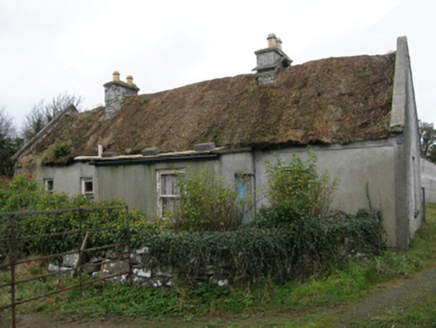Survey Data
Reg No
31312303
Rating
Regional
Categories of Special Interest
Architectural, Social
Original Use
Farm house
Date
1841 - 1894
Coordinates
119306, 252072
Date Recorded
08/03/2012
Date Updated
--/--/--
Description
Detached five-bay single-storey direct entry thatched farmhouse with dormer attic, extant 1894, originally four-bay single-storey[?] with single-bay single-storey lean-to projecting porch. Extended, pre-1924, producing present composition[?]. Disused, 2007. Derelict, 2011. Pitched reed or straw thatch roof on collared timber construction overhanging gablet to window opening to dormer attic to rear (north) pitch with degraded ridge retaining steel scallops, fine roughcast chimney stacks having chamfered capping supporting terracotta or yellow terracotta tapered pots, and concrete or rendered coping to gables. Cement rendered battered wall to front (south) elevation bellcast over rendered plinth with rendered strips to corners supporting rendered band to eaves; limewashed line rendered surface finish (remainder). Square-headed window openings with dragged cut-limestone sills, and concealed dressings framing one-over-one timber sash windows having part exposed sash boxes with two-over-two timber sash (ground floor) or timber casement (dormer attic) windows to rear (north) elevation. Square-headed opposing door openings with fittings not visible. Set back from road in unkempt grounds with cast-iron colonette piers to perimeter supporting looped flat iron double gates.
Appraisal
A dilapidated farmhouse identified as an important component of the nineteenth-century vernacular heritage of south County Mayo by such attributes as the lengthy direct entry plan form; the construction in unrefined local fieldstone demonstrating a feint battered silhouette; and the high pitched roof showing a degraded thatch finish: meanwhile, a comparison of the second (surveyed 1894; published 1897) and third (surveyed 1924; published 1929) editions of the Ordnance Survey illustrates the continued linear development of the farmhouse in the early twentieth century. A prolonged period of neglect notwithstanding, the elementary form and massing survive intact together with substantial quantities of the historic or original fabric, both to the exterior and to the interior, thereby upholding much of the character or integrity of the composition. Furthermore, adjacent outbuildings (extant 1924) continue to contribute positively to the group and setting values of a neat self-contained ensemble making a pleasing, if increasingly-obscure visual statement in a sylvan street scene.













